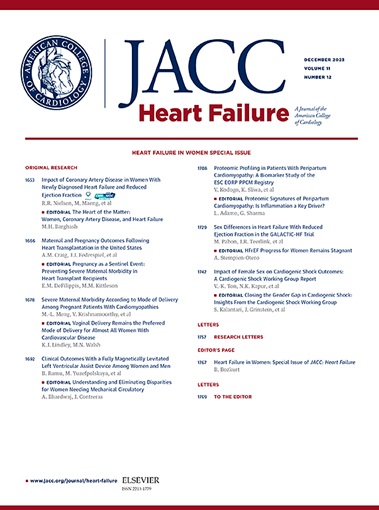Hospitalized Advanced Heart Failure With Preserved vs Reduced Left Ventricular Ejection Fraction
IF 10.3
1区 医学
Q1 CARDIAC & CARDIOVASCULAR SYSTEMS
引用次数: 0
Abstract
Background
Outcomes of hospitalized patients with heart failure (HF) and characteristics of advanced HF stage may vary across left ventricular ejection fraction (LVEF) and world regions.
Objectives
This study sought to analyze characteristics of hospitalized advanced HF patients across LVEF spectrum, world regions, and country income.
Methods
Among 18,553 hospitalized patients with acute HF (7,902 new-onset HF and 10,651 decompensated chronic HF) enrolled in the global registry REPORT-HF (International Registry to Assess Medical Practice With Longitudinal Observation for Treatment of Heart Failure), the authors analyzed characteristics and outcomes of patients with advanced HF, defined as previously diagnosed HF; severe symptoms before current admission (NYHA functional class III/IV); and ≥1 HF-related hospitalization in the preceding 12 months, excluding the current. Differences among hospitalized advanced HF subgroups stratified by LVEF, world region, and country income were examined.
Results
Among 6,999 patients with decompensated chronic HF and available previous NYHA functional class and HF hospitalization status, 3,397 (48.5%; 18.3% of the total population) had advanced HF. Of these, 44.5% had severely reduced (≤30%), 34.9% mildly/moderately reduced (31%-49%), and 20.7% preserved (≥50%) LVEF. Patients from Eastern Europe had the lowest 1-year mortality (23%), whereas those from Southeast Asia had the highest (37%). Patients from lower-middle-income countries were younger, with shorter HF duration and lower comorbidity prevalence, received fewer beta-blockers and HF-devices, and had higher 1-year mortality (34%) than upper-middle-income (26%) or high-income countries (27%; P = 0.018). Adjusted 1-year mortality risk did not differ among LVEF subgroups (all P > 0.05), nor did 1-year HF hospitalization rate (P = 0.56).
Conclusions
Hospitalized patients with advanced HF and preserved LVEF had similarly adverse outcomes as those with reduced LVEF. Patients from lower-middle-income countries had less implementation of HF therapies and higher 1-year mortality.
左心室射血分数保留与降低的晚期心力衰竭住院患者:全球视角。
背景:不同左心室射血分数(LVEF)和世界不同地区的心力衰竭(HF)住院患者的治疗结果和HF晚期的特征可能有所不同:本研究旨在分析不同左心室射血分数范围、世界不同地区和不同国家收入的晚期心力衰竭住院患者的特征:在全球注册研究 REPORT-HF(国际心力衰竭治疗纵向观察评估医疗实践注册研究)登记的 18553 名急性心力衰竭住院患者(7902 名新发心力衰竭患者和 10651 名失代偿慢性心力衰竭患者)中,我们分析了晚期心力衰竭患者的特征和预后,晚期心力衰竭患者的定义是:既往诊断为心力衰竭;本次入院前症状严重(NYHA 功能分级 III/IV);在过去 12 个月中(不包括本次)≥1 次与心力衰竭相关的住院治疗。研究还考察了按LVEF、世界地区和国家收入分层的晚期HF住院亚组之间的差异:在 6999 名患有失代偿性慢性心房颤动并可提供既往 NYHA 功能分级和心房颤动住院情况的患者中,有 3397 人(占总人口的 48.5%;18.3%)患有晚期心房颤动。其中,44.5%的患者 LVEF 严重降低(≤30%),34.9%的患者 LVEF 轻度/中度降低(31%-49%),20.7%的患者 LVEF 保留(≥50%)。东欧患者的 1 年死亡率最低(23%),而东南亚患者的 1 年死亡率最高(37%)。与中上收入国家(26%)或高收入国家(27%;P = 0.018)相比,中低收入国家的患者更年轻,心房颤动持续时间更短,合并症发生率更低,接受β-受体阻滞剂和心房颤动器械治疗的人数更少,1年死亡率(34%)更高。调整后的1年死亡风险在LVEF亚组之间没有差异(所有P > 0.05),1年HF住院率也没有差异(P = 0.56):结论:晚期心房颤动且 LVEF 保持不变的住院患者与 LVEF 降低的患者有着相似的不良预后。来自中低收入国家的患者较少接受心房颤动治疗,1年死亡率较高。
本文章由计算机程序翻译,如有差异,请以英文原文为准。
求助全文
约1分钟内获得全文
求助全文
来源期刊

JACC. Heart failure
CARDIAC & CARDIOVASCULAR SYSTEMS-
CiteScore
21.20
自引率
2.30%
发文量
164
期刊介绍:
JACC: Heart Failure publishes crucial findings on the pathophysiology, diagnosis, treatment, and care of heart failure patients. The goal is to enhance understanding through timely scientific communication on disease, clinical trials, outcomes, and therapeutic advances. The Journal fosters interdisciplinary connections with neuroscience, pulmonary medicine, nephrology, electrophysiology, and surgery related to heart failure. It also covers articles on pharmacogenetics, biomarkers, and metabolomics.
 求助内容:
求助内容: 应助结果提醒方式:
应助结果提醒方式:


